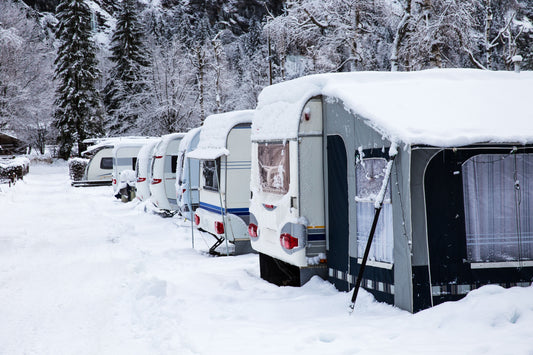
Where to Look for a Dead Mouse in Your Car — and What to Do About It
Share
You get in your car and somethings smells … off.
Not just musty. Not like dirty laundry or even spoiled food. But like something has died. You roll the windows down, clean out the trash, vacuum, and wipe down the seats, but the smell won’t go away. What do you do?
Unfortunately, a dead mouse is a very real possibility — and finding it can be easier said than done.
In this guide, we’ll walk you through where to begin your search, how to do it safely, and what to do once you find it. And if you still can’t locate the source of the smell, we’ll cover that too.
TABLE OF CONTENTS
- Signs of a Dead Mouse
- Where to Look
- What to Do If You Can't Find It?
- How to Remove Dead Mouse
- Prevention Tips
- FAQs

Signs You May Have a Dead Mouse in Your Car
The first stage of grief is denial. And the same can be said for a car full of dead mice.
Let it be moldy bread or spoiled milk or forgotten trash, but please … let it be anything but a dead mouse!
It can often feel easier to ignore the stench and explain it away than to accept the truth that a mouse has hidden away and died inside your vehicle. But if you’re ready for some acceptance, here are some common signs to be on the lookout for:
Odor-Based Clues (The Most Telltale Sign)
The most obvious — and unsettling — sign of a dead mouse is the smell. It’s a distinct, hard-to-ignore scent that only gets worse with time.
Look for:
- Rotten or decaying smell: Often described as a mix of spoiled meat, mold, and sewage.
- Sharp or sour edge: Especially common during early decomposition.
- Smell intensifies with heat: If your car has been sitting in the sun or your heater is on, the odor may worsen dramatically.
- Airflow-sensitive scent: If the odor is stronger when you turn on the A/C or vents, the source may be inside your HVAC system.
Note: A dead mouse smell is different from musty or mildew odors caused by water leaks or mold. It has a biological, unmistakable edge.
Visual and Physical Evidence
Sometimes, your eyes (or even your ears) offer the most indisputable evidence. Look for:
- Rodent droppings: Small, dark pellets concentrated near nesting areas—often under seats, in glove compartments, or near the trunk.
- Chewed materials or wiring: Mice often gnaw on insulation, paper, foam, or plastic. Check for exposed wires or shredded fabric.
- Nesting debris: Shredded paper, leaves, or soft materials balled up in out-of-sight areas like air filters, glove compartments, or floorboards.
- Fur or grease smears: Mice leave oily smudges along tight spaces or entry points as they squeeze through.
- Insect activity: An influx of flies, maggots, or gnats near floor mats, vents, or the trunk area can indicate a decomposing body.
Bonus Tip: If you hear faint scratching, squeaking, or rustling in the early stages, that’s a live mouse — act quickly before it becomes a dead one.

Where to Look for a Dead Mouse in Your Car
Master infiltrators, mice will reach places in your car you wouldn’t think possible. If you’re starting your search, here are some common areas to check:
Inside the Cabin
Mice are unlikely to die out in the open, but there are plenty of surprisingly tight spaces to hide inside your vehicle cabin. Look closely:
- Under the seats: Especially if your car hasn’t been used in a while.
- Behind the glove box: Sometimes accessible by removing a few screws.
- Under the carpet or floor insulation: Check for unusual lumps or stains.
- Inside center consoles, cupholders, or storage bins: Rare but possible if they got trapped inside.
Under the Hood
This is a good place to begin your search, especially if the smell is strongest when you pop the hood.
- Engine block or manifold: Mice love the warmth and might crawl in to nest — or die.
- Air filter box: Unscrew the cover and check inside for debris or nesting material.
- Under the battery tray or fuse box: Shine a flashlight under and around these tight spaces.
Tip: Always wear gloves and use a flashlight or inspection mirror to check hard-to-see spots.
Inside the HVAC System
If the smell gets worse when the air is on, the mouse likely burrowed inside your ventilation system.
- Cabin air filter compartment: Remove the cabin air filter and inspect the housing.
- Blower motor fan: If accessible, check for signs of blockage or debris.
- Deep HVAC ducts: Mice can crawl surprisingly deep. Unfortunately, you might need a mechanic to access these areas safely.
In the Trunk or Rear Panels
If the smell seems strongest near the rear of the car, try:
- Spare tire well: Lift the trunk mat and check around the tire.
- Behind trunk side panels or interior fender wells: You may need to pop off some paneling.
Underneath the Vehicle
Still can’t find it? Try checking beneath the car.
- Wheel wells and splash guards
- Underbody insulation or skid plates

What to Do if You Can’t Find the Dead Mouse
It happens more than you’d think.
If you’ve looked everywhere you can safely reach and still can’t find the mouse — but the smell persists — here are your options:
- Use your nose methodically: Smell near each vent, under the car, and around the trunk.
- Call a mechanic or auto detailer: Professionals have better access to internal components, including HVAC ducts and under-dash areas.
- Request ozone treatment: Some detailers offer ozone machines that neutralize odors, even if the source can’t be removed (best to have a professional handle).
- Use a borescope camera: These can be snaked into tight areas to look for carcasses or nesting materials.
Important: Even if you can’t find it, the odor will likely not go away on its own anytime soon. Decomposition can take weeks or months, especially in cooler temps.
How to Safely Remove It (and Clean Up After)
Once you find the mouse, it is critical that you remove it and all other debris safely. Mice carry disease that can be transmitted through direct contact and inhalation. Follow these precautions:
- Wear gloves and a mask. This protects you from bacteria, viruses, or parasites.
- Remove the carcass using a grabber or paper towels. Double-bag and seal before disposing in an outdoor trash bin.
- Clean the area with an enzymatic cleaner. Avoid bleach — it can react poorly with urine and doesn’t neutralize odor proteins.
- Replace your cabin air filter. Even if the mouse wasn’t directly in it, filters easily absorb odors.
- Ventilate and dry the car. Crack the windows and run the fan to help clear out lingering smells.
If you are still struggling to remove the odor, check out our full guide on How to Get Mouse Smell Out of Your Car.
How to Prevent Mice from Dying in Your Car Again
Discovering there’s a dead mouse in your car is bad enough. But having it happen again? No, thank you. Don’t let mice become a recurring problem. Here’s how you can prevent rodents from getting into your vehicle in the first place:
1. Eliminate What’s Attracting Them
Mice are drawn to three things: food, warmth, and nesting materials. Get rid of those, and your car becomes a lot less appealing.
- Don’t leave food wrappers, crumbs, pet food, or groceries in the car — even for a night.
- Vacuum your floors and seats regularly.
- Remove blankets, tissues, napkins, or clutter that mice might use for nesting.
2. Seal Entry Points (As Best You Can)
Mice can jump, climb, and squeeze their way into your car — they are expert invaders. Don’t make it easy for them by leaving a doorway open.
- Check for gaps around cabin air intakes, wheel wells, and undercarriage insulation.
- Make sure garage doors and storage areas are weather-sealed and rodent-proof.
- Use steel wool or mesh to plug holes or access points around wiring if parking in a rodent-prone area.
3. Rethink How You Store Your Vehicle
A stored vehicle is a vulnerable vehicle. If you won’t be driving your car for more than a few weeks, it’s important that you take proper precautions.
- If you’re parking your car or RV for an extended period, avoid doing so near trash bins, woodpiles, compost, or tall grass.
- Open the hood slightly to reduce warm hiding places.
- Pop the glove box or remove air filters when storing the vehicle long term to discourage nesting in dark, quiet areas.
Tip: Check out our guide on Vehicle Storage Options.
4. Use a Box-Kat Mouse Barrier
Most repellents—peppermint oil, mothballs, dryer sheets—offer short-term deterrence at best. Rodents quickly adapt to smells and often ignore them.
If you’re serious about stopping mice from ever getting inside, use a physical barrier like the Box-Kat.
It’s trusted by car collectors, RV owners, and anyone tired of dealing with chewed wires and foul odors. If your car is parked outside or in a garage with known rodent activity, this is your first line of defense.
FAQs
What does a dead mouse smell like in a car?
Rotten, sour, or “meaty.” It can be subtle at first but often becomes overpowering.
How long does the smell last?
Without removal, the odor can linger for weeks or months, depending on temperature and ventilation.
Can I drive with a dead mouse in my car?
Technically yes — but it’s not advised. The smell can be nauseating, and exposure to decomposition gases or bacteria isn’t ideal.
Will the smell eventually go away?
Only after the body fully decomposes, which may take longer than you’d expect. Removing the source is the best bet.
Can mechanics find and remove it?
Yes — many mechanics and auto detailers deal with this regularly and can access areas you can’t safely reach.

Final Thoughts
Don’t wait — or hope — for the bad smell to pass. If you suspect a dead mouse in your car, act quickly to locate and remove the source. With the right tools and a little patience, you can get your car back to smelling like a car again.
And if you’re planning on storing your vehicle this offseason, consider protecting it with a barrier that mice can’t get past — because it’s always easier to keep them out than deal with what happens once they’re in.



